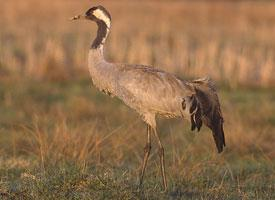
Weights and measures
| Length | 1 m |
|---|---|
| Weight | 3,6 kg |
| Wingspan | 1,87 m |
Animal description
The Black crowned crane (Balearica pavonina) is a captivating bird species, notable for its unique combination of elegance and distinctive features. As a member of the crane family, it stands out with its remarkable appearance and behavior, embodying a blend of grace and strength that fascinates bird enthusiasts and wildlife observers alike.Physical Characteristics:
The Black crowned crane boasts an impressive stature, with adults reaching heights of about 1 to 1.2 meters (3.3 to 3.9 feet). One of its most striking features is its plumage. The body is predominantly covered in slate grey feathers, which contrast beautifully with the white wings that are conspicuously displayed during flight. The wingtips are adorned with a darker shade, adding to the bird's majestic appearance.
The crane's head is a canvas of vivid colors and unique features. It sports a crown of stiff golden feathers, which stands in stark contrast to the deep black face and neck. The cheeks are adorned with bright red and white patches, adding to the visual spectacle. The bird's piercing eyes are surrounded by large, white patches, further accentuating its striking facial features.
A notable characteristic of the Black crowned crane is its beak, which is relatively short and grey, designed for its omnivorous diet. Completing the bird's distinct profile is its long, slender legs, which are a pale grey color, enabling it to wade through wetlands and grasslands in search of food.
Habitat and Distribution:
The Black crowned crane is native to the African continent, with its range extending across the Sahel and Sudan-Guinea Savanna zones. It prefers wetland habitats, including marshes, shallow lakes, and flooded fields, where it can find ample food and nesting sites. The species is also found in grasslands and agricultural fields, adapting to various environments within its range.
Behavior and Diet:
Black crowned cranes are social birds, often seen in pairs or small family groups. They are known for their elaborate courtship dances, which involve a series of jumps, bows, and calls that strengthen bonds between mates. The species exhibits a variety of vocalizations, from loud trumpeting calls to softer, more melodious sounds, used for communication within the group.
An omnivorous feeder, the Black crowned crane's diet includes a mix of plant and animal matter. It feeds on seeds, grains, insects, frogs, and small fish, foraging in shallow waters or on land, depending on the availability of food sources.
Conservation Status:
The Black crowned crane is classified as Vulnerable by the International Union for Conservation of Nature (IUCN), facing threats from habitat loss, degradation, and fragmentation. Wetland drainage for agriculture, along with increased human settlement and water pollution, has led to a decline in suitable habitats. The species is also affected by illegal hunting and capture for the pet trade. Conservation efforts are focused on habitat protection, research, and community engagement to ensure the survival of this remarkable bird.
In summary, the Black crowned crane is an emblem of the natural beauty and diversity of Africa's birdlife. Its striking appearance, complex behaviors, and the challenges it faces in the wild highlight the importance of conservation efforts to protect these magnificent birds and their habitats for future generations.
Similar Animals
New photos of animals
Top 10 animals
- Dolphin gull (Leucophaeus scoresbii)
- Diana monkey (Cercopithecus diana)
- Moustached guenon (Cercopithecus cephus)
- Galápagos tortoise (Geochelone nigra complex)
- Stone loach (Barbatula barbatula)
- Japanese macaque (Macaca fuscata)
- Greek tortoise (Testudo graeca)
- Russian tortoise (Testudo horsfieldii)
- Common flying dragon (Draco volans)
- Galápagos penguin (Spheniscus mendiculus)


